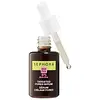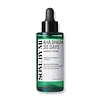What's inside
What's inside
 Key Ingredients
Key Ingredients

 Benefits
Benefits

 Concerns
Concerns

 Ingredients Side-by-side
Ingredients Side-by-side

Water
Skin ConditioningGluconolactone
Skin ConditioningPropanediol
SolventButylene Glycol
HumectantPentylene Glycol
Skin ConditioningAlcohol Denat.
AntimicrobialSilica
AbrasiveSodium Hydroxide
BufferingAmmonium Acryloyldimethyltaurate/Vp Copolymer
Sodium Acrylates Copolymer
Glyceryl Caprylate
EmollientSalicylic Acid
MaskingXanthan Gum
EmulsifyingLecithin
EmollientEnantia Chlorantha Bark Extract
Skin ConditioningSodium Benzoate
MaskingSodium Phytate
Helianthus Annuus Seed Oil
EmollientRosmarinus Officinalis Leaf Extract
AntimicrobialT-Butyl Alcohol
PerfumingOleanolic Acid
Skin ConditioningDenatonium Benzoate
MaskingWater, Gluconolactone, Propanediol, Butylene Glycol, Pentylene Glycol, Alcohol Denat., Silica, Sodium Hydroxide, Ammonium Acryloyldimethyltaurate/Vp Copolymer, Sodium Acrylates Copolymer, Glyceryl Caprylate, Salicylic Acid, Xanthan Gum, Lecithin, Enantia Chlorantha Bark Extract, Sodium Benzoate, Sodium Phytate, Helianthus Annuus Seed Oil, Rosmarinus Officinalis Leaf Extract, T-Butyl Alcohol, Oleanolic Acid, Denatonium Benzoate
Water
Skin ConditioningCentella Asiatica Extract 77%
CleansingCetyl Ethylhexanoate
EmollientCaprylic/Capric Triglyceride
MaskingGlycerin
HumectantOlea Europaea Fruit Oil
MaskingPropanediol
SolventAlcohol
AntimicrobialButylene Glycol
Humectant1,2-Hexanediol
Skin ConditioningNiacinamide
SmoothingMelaleuca Alternifolia Leaf Water
AntimicrobialCamellia Sinensis Leaf Extract
AntimicrobialScutellaria Baicalensis Root Extract
AstringentPolygonum Cuspidatum Root Extract
AntioxidantGlycyrrhiza Glabra Root Extract
BleachingChamomilla Recutita Flower Extract
MaskingRosmarinus Officinalis Leaf Extract
AntimicrobialSodium Lactate
BufferingSodium PCA
HumectantCitric Acid
BufferingLactic Acid
BufferingMalic Acid
BufferingGlycolic Acid
BufferingPyruvic Acid
MaskingTartaric Acid
BufferingGaultheria Procumbens Leaf Extract
PerfumingLactobionic Acid
BufferingPentylene Glycol
Skin ConditioningVaccinium Macrocarpon Fruit Extract
AstringentLavandula Angustifolia Extract
Skin ConditioningOcimum Basilicum Leaf Extract
Skin ConditioningSyringa Vulgaris Extract
Skin ConditioningHouttuynia Cordata Extract
Skin ConditioningAngelica Keiskei Extract
AntioxidantAlthaea Officinalis Root Extract
Skin ConditioningRosmarinus Officinalis Extract
AntimicrobialMadecassoside
AntioxidantCamellia Oleifera Seed Oil
Skin ConditioningOryza Sativa Bran Oil
EmollientCamellia Sinensis Seed Oil
HumectantRosa Canina Fruit Oil
EmollientPrunus Amygdalus Dulcis Oil
Skin ConditioningLimnanthes Alba Seed Oil
Skin ConditioningSodium Chloride
MaskingCitrus Paradisi Peel Oil
MaskingCitrus Aurantium Dulcis Peel Oil
MaskingCurcuma Longa Root Extract
MaskingMelia Azadirachta Leaf Extract
Skin ConditioningMelia Azadirachta Flower Extract
Skin ConditioningXanthan Gum
EmulsifyingPelargonium Graveolens Flower Oil
MaskingBoswellia Carterii Oil
MaskingMelia Azadirachta Bark Extract
AntimicrobialPearl Powder
Amyris Balsamifera Bark Oil
MaskingMoringa Oleifera Seed Oil
EmollientOcimum Sanctum Leaf Extract
Skin ConditioningOcimum Basilicum Flower/Leaf Extract
TonicDisodium EDTA
Caprylyl Glycol
EmollientEthylhexylglycerin
Skin ConditioningWater, Centella Asiatica Extract 77%, Cetyl Ethylhexanoate, Caprylic/Capric Triglyceride, Glycerin, Olea Europaea Fruit Oil, Propanediol, Alcohol, Butylene Glycol, 1,2-Hexanediol, Niacinamide, Melaleuca Alternifolia Leaf Water, Camellia Sinensis Leaf Extract, Scutellaria Baicalensis Root Extract, Polygonum Cuspidatum Root Extract, Glycyrrhiza Glabra Root Extract, Chamomilla Recutita Flower Extract, Rosmarinus Officinalis Leaf Extract, Sodium Lactate, Sodium PCA, Citric Acid, Lactic Acid, Malic Acid, Glycolic Acid, Pyruvic Acid, Tartaric Acid, Gaultheria Procumbens Leaf Extract, Lactobionic Acid, Pentylene Glycol, Vaccinium Macrocarpon Fruit Extract, Lavandula Angustifolia Extract, Ocimum Basilicum Leaf Extract, Syringa Vulgaris Extract, Houttuynia Cordata Extract, Angelica Keiskei Extract, Althaea Officinalis Root Extract, Rosmarinus Officinalis Extract, Madecassoside, Camellia Oleifera Seed Oil, Oryza Sativa Bran Oil, Camellia Sinensis Seed Oil, Rosa Canina Fruit Oil, Prunus Amygdalus Dulcis Oil, Limnanthes Alba Seed Oil, Sodium Chloride, Citrus Paradisi Peel Oil, Citrus Aurantium Dulcis Peel Oil, Curcuma Longa Root Extract, Melia Azadirachta Leaf Extract, Melia Azadirachta Flower Extract, Xanthan Gum, Pelargonium Graveolens Flower Oil, Boswellia Carterii Oil, Melia Azadirachta Bark Extract, Pearl Powder, Amyris Balsamifera Bark Oil, Moringa Oleifera Seed Oil, Ocimum Sanctum Leaf Extract, Ocimum Basilicum Flower/Leaf Extract, Disodium EDTA, Caprylyl Glycol, Ethylhexylglycerin
 Reviews
Reviews

Ingredients Explained
These ingredients are found in both products.
Ingredients higher up in an ingredient list are typically present in a larger amount.
Butylene Glycol (or BG) is used within cosmetic products for a few different reasons:
Overall, Butylene Glycol is a safe and well-rounded ingredient that works well with other ingredients.
Though this ingredient works well with most skin types, some people with sensitive skin may experience a reaction such as allergic rashes, closed comedones, or itchiness.
Learn more about Butylene GlycolPentylene glycol is typically used within a product to thicken it. It also adds a smooth, soft, and moisturizing feel to the product. It is naturally found in plants such as sugar beets.
The hydrophilic trait of Pentylene Glycol makes it a humectant. As a humectant, Pentylene Glycol helps draw moisture from the air to your skin. This can help keep your skin hydrated.
This property also makes Pentylene Glycol a great texture enhancer. It can also help thicken or stabilize a product.
Pentylene Glycol also acts as a mild preservative and helps to keep a product microbe-free.
Some people may experience mild eye and skin irritation from Pentylene Glycol. We always recommend speaking with a professional about using this ingredient in your routine.
Pentylene Glycol has a low molecular weight and is part of the 1,2-glycol family.
Learn more about Pentylene GlycolPropanediol is an all-star ingredient. It softens, hydrates, and smooths the skin.
It’s often used to:
Propanediol is not likely to cause sensitivity and considered safe to use. It is derived from corn or petroleum with a clear color and no scent.
Learn more about PropanediolRosmarinus Officinalis Leaf Extract comes from rosemary. Rosemary is native to the Mediterranean.
While Rosmarinus Officinalis Leaf Oil can be volatile due to its fragrant properties, the fragrance components are usually removed in the leaf extract.
Rosemary Leaf Extract contains many antioxidants such as rosmarinic acid and caffeic acid. Rosemarinic acid, a compound found in rosemary leaf, has been found to help soothe skin conditions such as eczema and acne.
Learn more about Rosmarinus Officinalis Leaf ExtractWater. It's the most common cosmetic ingredient of all. You'll usually see it at the top of ingredient lists, meaning that it makes up the largest part of the product.
So why is it so popular? Water most often acts as a solvent - this means that it helps dissolve other ingredients into the formulation.
You'll also recognize water as that liquid we all need to stay alive. If you see this, drink a glass of water. Stay hydrated!
Learn more about WaterXanthan gum is used as a stabilizer and thickener within cosmetic products. It helps give products a sticky, thick feeling - preventing them from being too runny.
On the technical side of things, xanthan gum is a polysaccharide - a combination consisting of multiple sugar molecules bonded together.
Xanthan gum is a pretty common and great ingredient. It is a natural, non-toxic, non-irritating ingredient that is also commonly used in food products.
Learn more about Xanthan Gum